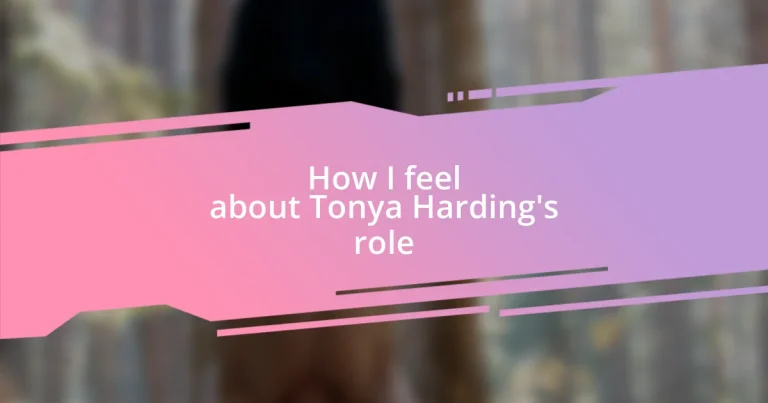Key takeaways:
- Tonya Harding’s challenging upbringing and turbulent relationship with her mother shaped her resilience and determination in figure skating.
- Her involvement in the attack on Nancy Kerrigan transformed her public perception, making her both a controversial figure and a symbol of resilience within the competitive sports landscape.
- The media’s portrayal of Harding shifted dramatically over time, reflecting societal attitudes towards women and complicating her narrative as both an athlete and a person facing public scrutiny.
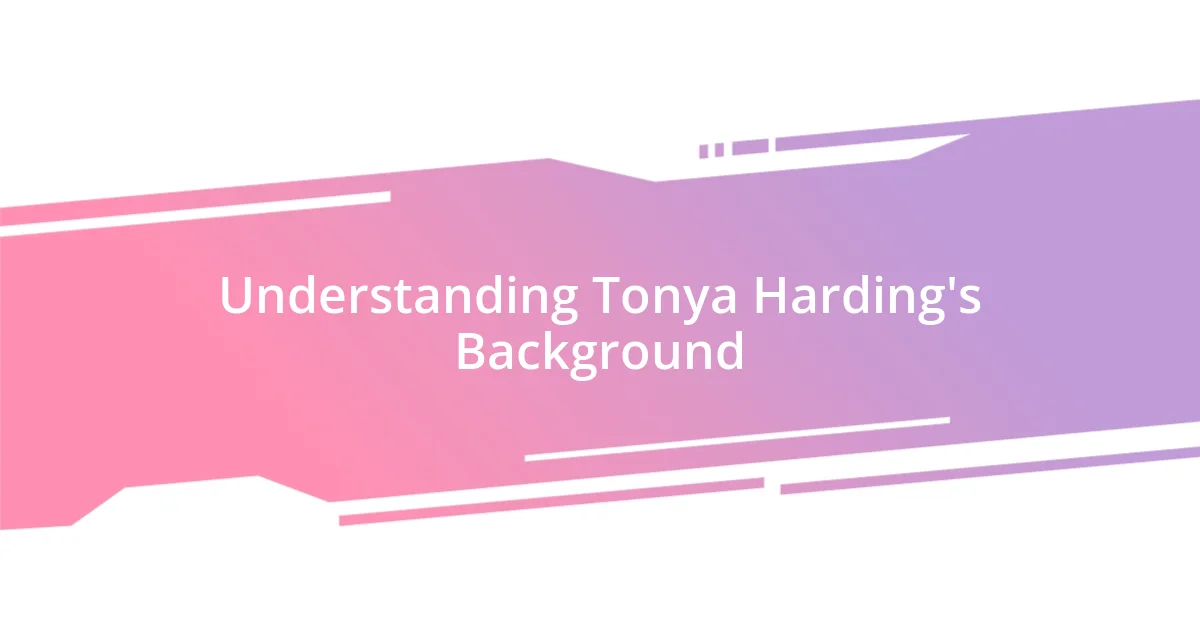
Understanding Tonya Harding’s Background
Tonya Harding’s upbringing is a tapestry woven with challenges and resilience. Growing up in a low-income family in Portland, Oregon, she faced instability that many of us can barely imagine. I often wonder how such a tough start shapes a person’s spirit—does it build an unyielding drive, or does it create a feeling of being trapped? For Tonya, it certainly seemed to ignite a fierce passion for figure skating, which ultimately became both her refuge and her battleground.
Her relationship with her mother, LaVona, was turbulent, marked by immense pressure and criticism. As I reflect on how formative relationships can be, I can’t help but think about the impact of such a dynamic. Can you imagine training endlessly under a watchful eye that feels more like a taskmaster than a supporter? It’s no surprise that this intense environment forced Harding to develop an edge—a resilience that would later define her career both on and off the ice.
But it wasn’t just her family life shaping her story; the world of competitive skating was another formidable force. I remember witnessing how much the sport valued grace and femininity, while Tonya embodied a more rugged, raw approach. Her struggle to fit into a mold created by others raises an interesting question: What happens when someone refuses to conform? For Tonya, this journey birthed a complex narrative that was as captivating as it was controversial.

Impact of Harding’s Actions
The impact of Harding’s actions reverberated far beyond the ice rink. Her involvement in the attack on Nancy Kerrigan not only tarnished her own reputation but also altered the public’s perception of figure skating. I remember watching that fateful moment when Nancy was hurt, feeling a wave of disbelief wash over me—how could something so violent seep into the world of grace and art? It was a pivotal moment in sports history, blurring the lines between athletic competition and personal vendettas.
In the aftermath, Harding became a symbol of both controversy and resilience. Some viewed her as a villain, while others found a strange admiration in her relentless fight against a system that seemed stacked against her. I’ve often pondered how people can champion the underdog while simultaneously condemning their actions. To me, Harding’s situation reflects a broader truth about human morality—our ability to see the complexities in decisions that lead to moral ambiguity.
The fallout also had a lasting impact on the sport itself. Athletes quickly realized that off-ice behavior could overshadow on-ice performance, changing how they approached their careers. I can’t help but feel that this awareness has led to a more polished public persona among skaters, prioritizing reputation over authenticity. It’s a bittersweet trade-off, as real stories often get lost behind manufactured images, yet it undeniably shaped the culture of competitive skating moving forward.
| Impact on Harding | Impact on Figure Skating |
|---|---|
| Tarnished reputation | Heightened scrutiny of athletes |
| Symbol of controversy | Shifted public perception |
| Catalyst for discussion on ethics | Changed media coverage |

Public Perception of Tonya Harding
Public perception of Tonya Harding is a complex tapestry, woven with threads of admiration, disdain, and intrigue. Initially, audiences were enchanted by her raw talent and fierce determination; however, after the incident with Nancy Kerrigan, opinions took a sharp turn. I recall feeling conflicted, watching news coverage that painted her as a tragic figure—a villain yet somehow a person to empathize with. Her story captured the essence of a societal struggle: how does one reconcile public adoration with public vilification?
- Many saw her as a misunderstood underdog fighting against societal norms.
- Others viewed her actions as a betrayal of the spirit of sport.
- The media frenzy created an unrelenting spotlight, framing her every move.
- Online discussions often teetered between outrage and unexpected support, revealing the polarized views people held.
Emotions ran high, and I found myself engaging in conversations where friends were split down the middle—some labeled her a cautionary tale, while others championed her grit. It’s fascinating how a singular moment can redefine a person’s legacy, leaving us to grapple with what it means to truly understand someone.
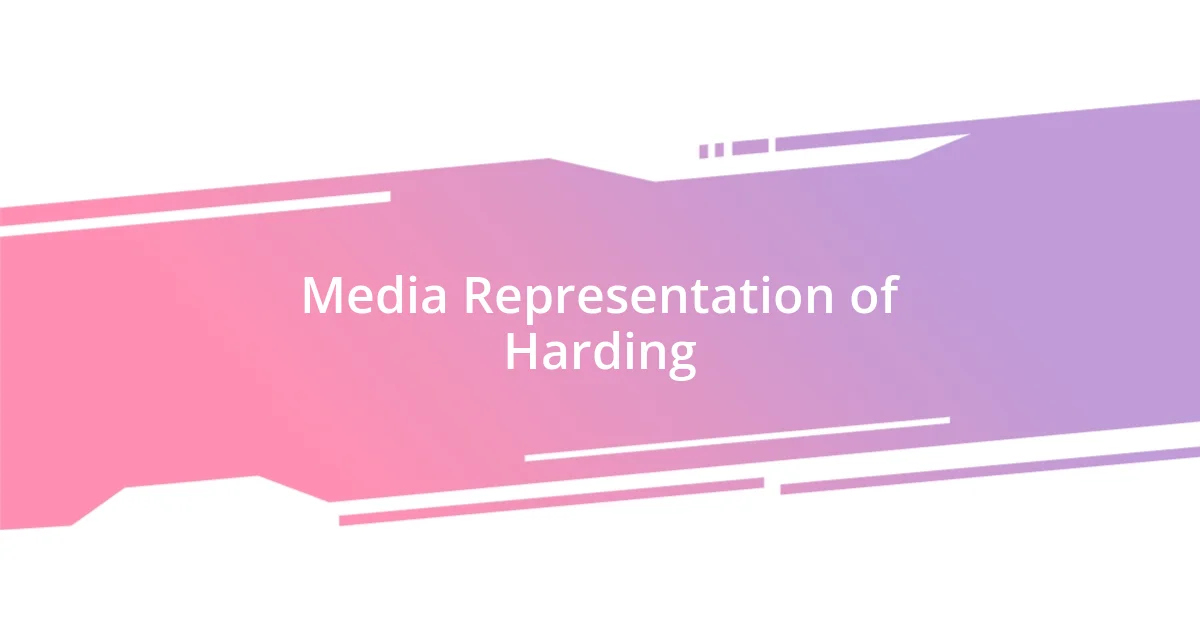
Media Representation of Harding
The media representation of Tonya Harding offers a striking example of how narrative can shape public perception. I remember tuning into the news during the height of the scandal, and it felt like every channel was broadcasting the same sensationalized version of events. They labeled Harding as a “bad girl” of figure skating, framing her as the ultimate villain in a drama that originally seemed about athletic rivalry. This headline-grabbing approach overshadowed the intricacies of her life story, making it hard for me to reconcile the girl who fought so hard to be seen with the image the media was constructing.
As I continued to follow her story, I was struck by how the portrayal evolved over time. There were those moments when the cameras zoomed in on her struggles, and I couldn’t help but feel a wave of empathy. The media tended to present her as both a tragic figure and an embodiment of defiance against an unforgiving system. It left me wondering: Can one incident truly define a person’s entire narrative? Those feelings of conflict resonated with many of my friends, who found it hard to label Harding simply as a villain when there were so many shades of gray in her life.
Ultimately, Harding’s representation in the media became a mirror, reflecting broader societal attitudes toward women who dare to disrupt norms. I remember discussing this with a close friend who saw Harding as a trailblazer, while others simply judged her for the infamous act. It made me think—how often do we allow a single misstep to overshadow an entire journey? Through the eyes of the media, Harding transitioned from a skilled athlete to a walking cautionary tale, a phenomenon that leaves us questioning the justice of such swift judgments.
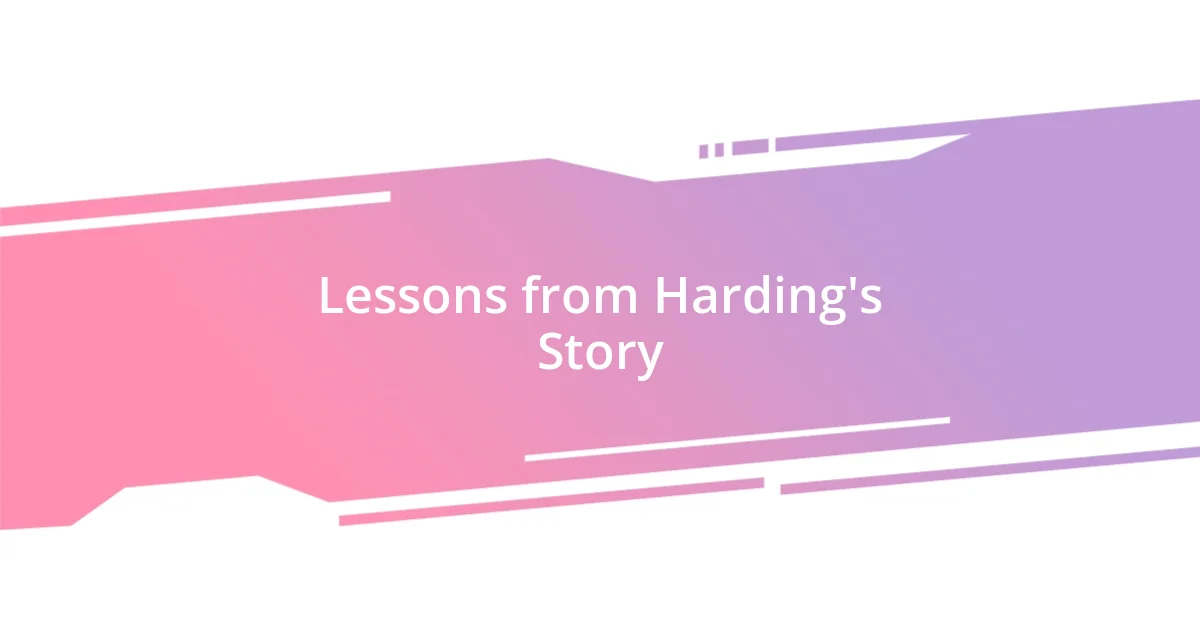
Lessons from Harding’s Story
The story of Tonya Harding teaches us about the complexities of human nature and the consequences of our choices. I often think about how a single moment can overshadow years of hard work and dedication. It raises a poignant question: How do we maintain our integrity when the world is watching closely, waiting for us to falter?
Harding’s journey reminds us of the importance of context in understanding a person’s actions. Reflecting on my own experiences, there have been times when I’ve been judged harshly without the full picture. This experience resonates with me because it emphasizes the value of empathy—understanding that everyone is fighting their own battles, often unseen by the public eye. Wouldn’t it be more compassionate to look beyond the headlines and seek to understand the struggles behind the scenes?
Moreover, Harding’s saga is a powerful lesson in the impact of media narratives. I’ve witnessed how easily public perception shifts based on what’s prominently featured in news reports or social media. It makes me wonder: Are we inadvertently complicit in shaping these narratives by sharing opinions without all the facts? Perhaps we should be more mindful of the stories we consume and share, recognizing our role in perpetuating complex tapestries like Harding’s.
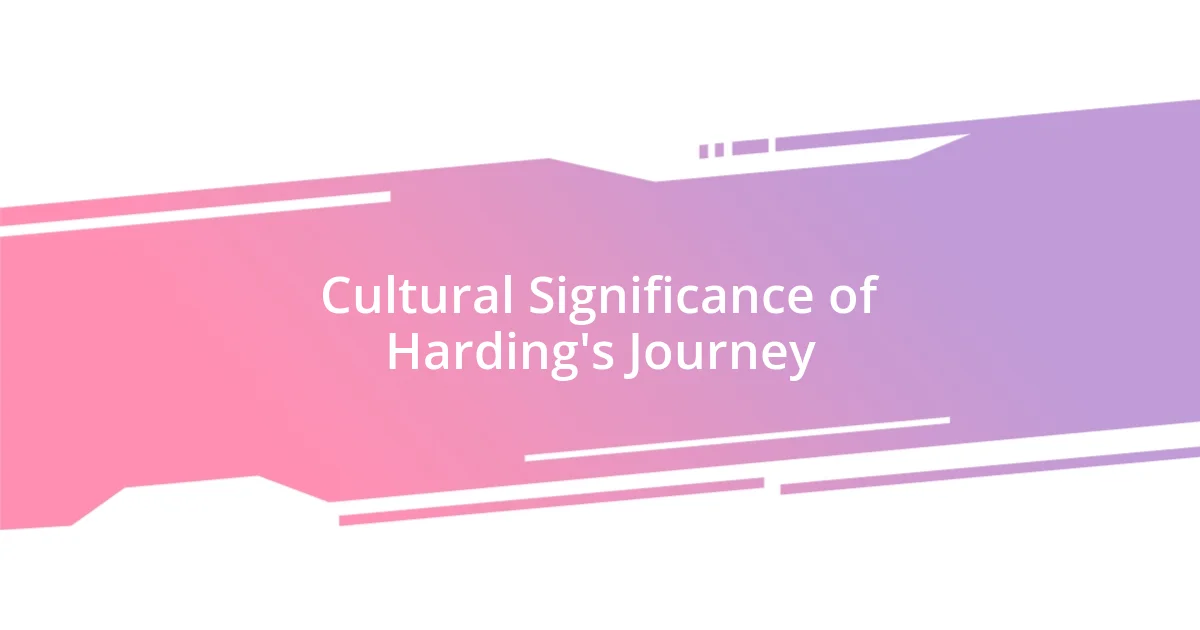
Cultural Significance of Harding’s Journey
The cultural significance of Tonya Harding’s journey resonates deeply with societal perceptions of women and perseverance. I recall sitting on my couch, glued to the TV, as the narrative flipped from depicting her as an athlete to a pariah. This shift made me realize how quickly society can cast judgment without fully understanding the intricacies of someone’s life. The questions began churning in my mind: What does it say about us when we so easily define someone by their failures?
Her story also sheds light on gender dynamics within competitive sports. I remember discussions with friends who mirrored my frustrations about how female athletes, in particular, are often scrutinized for their personalities rather than their performance. Harding’s fierce determination sometimes felt like a challenge to traditional femininity, which may explain why her journey sparked such polarized reactions. It made me wonder—how much do we allow societal expectations to dictate the narrative of a woman’s worth?
Ultimately, Harding symbolizes a broader cultural conversation about resilience in the face of scorn. I think back to moments in my life when I faced criticism for taking bold steps or standing out. Her journey serves as a poignant reminder: sometimes, our paths may be marred by missteps, but they also hold the potential for growth and transformation. By examining her cultural significance, I find myself questioning the ways we celebrate tenacity versus how we respond to downfall. Isn’t it critical to acknowledge both the triumphs and the tribulations in shaping a person’s legacy?
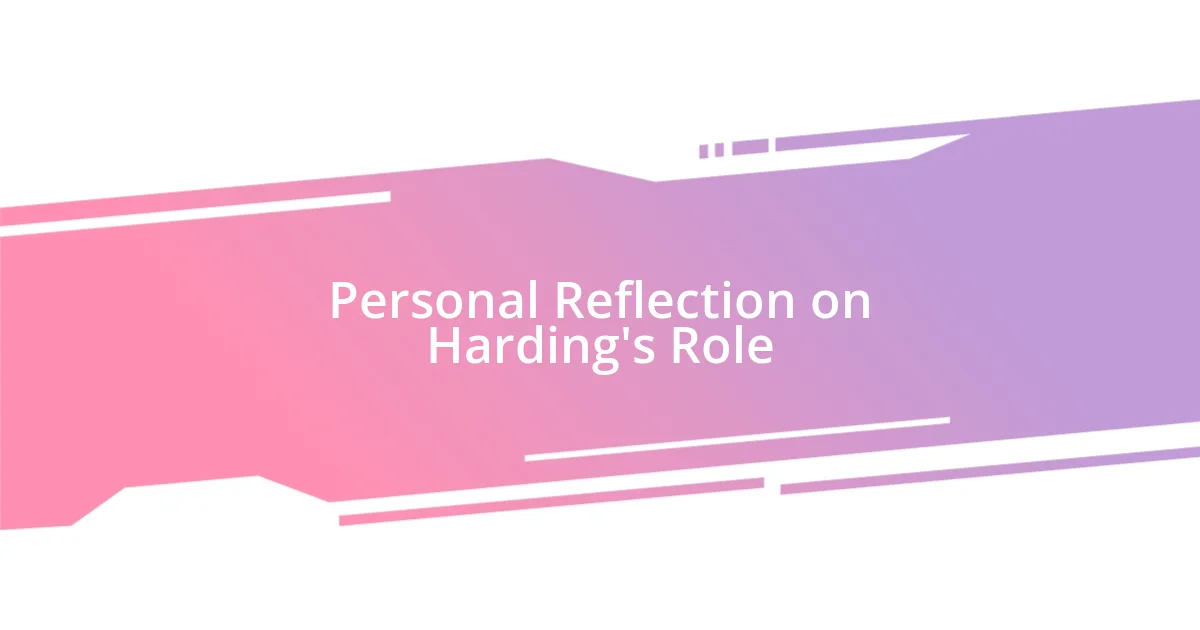
Personal Reflection on Harding’s Role
Reflecting on Tonya Harding’s role, I can’t help but feel a mix of empathy and frustration. Watching her rise and fall reminds me of situations where I felt misunderstood. There was a time during my own career when a single mistake nearly derailed years of dedication. That experience taught me how one misstep can resonate louder than a thousand successes, a truth that I see mirrored in Harding’s life.
When I think about how society shaped Harding’s narrative, I realize the importance of context. I remember cheering for athletes during high-stakes tournaments and feeling the pressure they face—not just from their opponents, but from an unyielding public eye. Harding’s experience makes me question: how often do we let our preconceived notions cloud our judgment of someone? It’s a reminder that there’s so much more beneath the surface, often hidden from the spotlight.
Moreover, her infamous story leads me to reflect on resilience in the face of public scrutiny. I once stood up for a friend who was unfairly criticized, and it was in that moment I learned how vital it is to defend those we care about. Imagining Harding navigating a world eager to label her as a villain pulls at my heartstrings. Doesn’t everyone deserve a chance for redemption and understanding, especially when they’ve faced such tumultuous trials?












